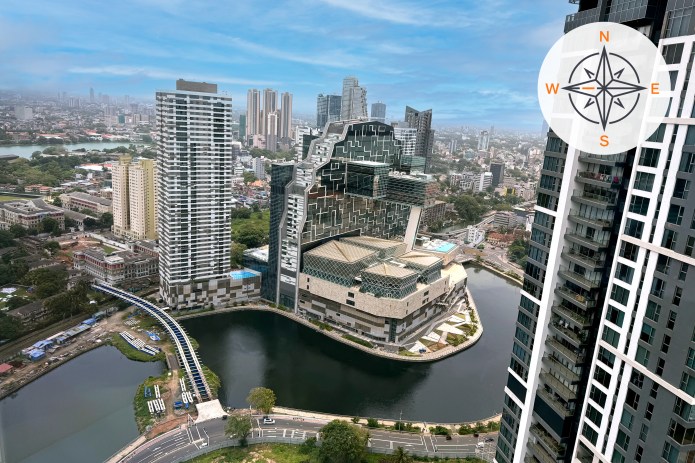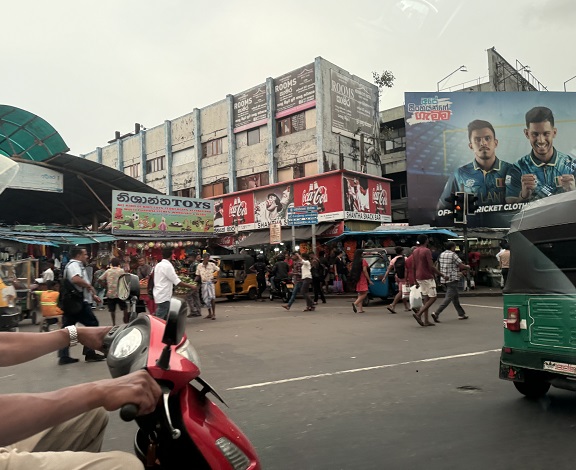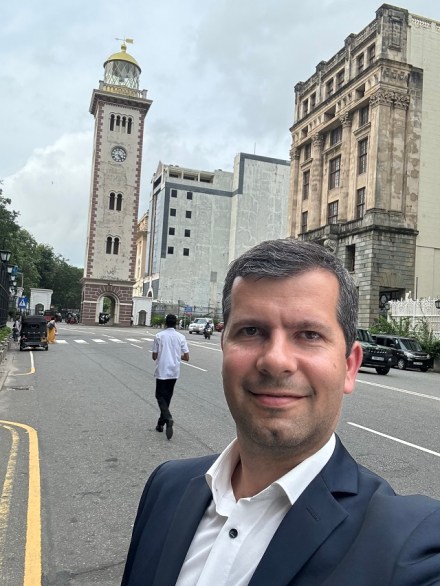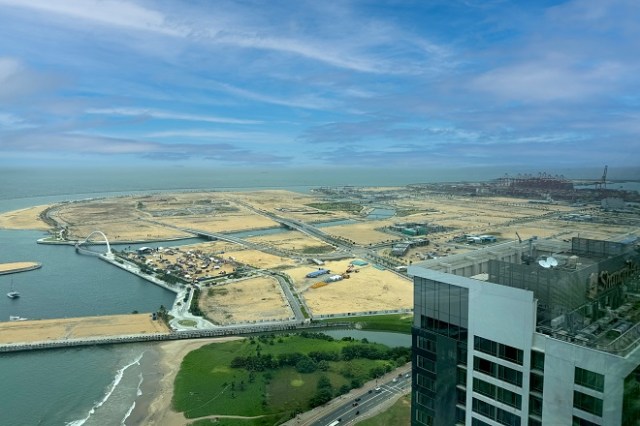JH Explorer in Sri Lanka: The teardrop island wipes away its tears
Portfolio Manager Sorin Pirău from the Emerging Markets Debt Hard Currency Team discusses his experience in Colombo as part of a research trip across Frontier South Asia and whether the pivotal elections mark a new path for the challenged country.

10 minute read
Key takeaways:
- Visiting Sri Lanka we observed a nation rebounding from economic crisis and default, poised for a landmark election that could impact its IMF-endorsed recovery plan and ongoing debt restructuring efforts.
- The election of president Anura Kumara Dissanayake brings a new, uncharted leadership to the country. Early signs are encouraging with his administration approving the final Eurobond deal and affirming its commitment to the IMF programme.
- From here on, the country’s forward momentum will depend on achieving consensus around vital structural reforms that will influence its credit rating and pricing of new sovereign bonds.
| The JH Explorer series follows our investment teams across the globe and shares their on-the-ground research at a country and company level. |
Choosing the right time to visit
One of the many challenges for emerging market (EM) investors is deciding the timing of country research visits, particularly around pivotal events which can significantly influence asset prices. This decision becomes even more complex in countries experiencing severe economic crises, undergoing external debt restructuring, and holding elections following significant unrest, as these factors add layers of uncertainty to the investment landscape. One example of such an event is a close-fought election that features candidates with divergent market views. Visiting before the election offers insight into each candidate’s policy agenda, their feasibility, and potential market reactions to the election outcomes. However, pre-election discussions may lean heavily towards speculative, short-term electoral consequences, which quickly become outdated post-election as markets adjust to the new reality.
On the other hand, scheduling a visit after the election uncertainty dissipates allows for more forward-looking discussions about concrete policies and macroeconomic outcomes, albeit at a time when bond prices might have already adjusted to reflect the perceived market friendliness of the elected candidate. In the end, there is no right or wrong answer, and the decision has to be taken on a case-by-case basis depending on the investment thesis that is being pursued.
The journey from revolution and default to economic rebound
Sri Lanka was slowly emerging from a devastating economic crisis that had led to President Gotabaya Rajapaksa fleeing to the Maldives in 2022 amid nationwide protests and the country defaulting on its debts during a harsh recession, characterised by high inflation and drained foreign exchange (currency) reserves. By early 2023, under the new leadership of President Ranil Wickremesinghe, Sri Lanka embarked on a four-year IMF-supported recovery programme that allowed the economy to stabilise and foster a gradual macroeconomic stabilisation. This included revenue-based fiscal consolidation that, together with envisaged progress on debt restructuring, was meant to bring down Sri Lanka’s eye-watering interest burden from a record level of almost 80% of government revenues in 2022 to more sustainable levels (Figure 1).
Figure 1: Interest (as a percent of government revenue) falling to more sustainable levels

Source: Janus Henderson Investors, Macrobond, IMF, as at 9 October 2024. 2024 and 2025 are forecasts. There is no guarantee that past trends will continue, or forecasts will be realised.
Landing in Colombo in early September 2024, we found a nation gearing up for a close election that for the first time in the country’s history was likely to go into a second round of counting where voters’ second and third preferences could play a decisive role1. The two frontrunners were Sajith Premadasa, the opposition leader who secured 42% of the vote in 2019, and Anura Kumara Dissanayake, also known as AKD, a lesser-known figure with a Marxist ideology leading a radical left-wing party. Through our conversations, it emerged that AKD’s chances of winning might be higher than the market consensus suggested, but at the same time his policies would likely not be as extreme or investor unfriendly as anticipated. Despite his manifesto calling for a “renegotiation” of the IMF programme and an “alternative debt sustainability analysis”—factors that could disrupt or compromise the IMF programme reviews and Eurobond restructuring—his emphasis on the rule of law2 and combatting corruption could, if effectively implemented, foster positive outcomes for the country.
Defying predictions, a final hour agreement emerges…
The streets of Colombo

Source: Janus Henderson Investors.
The events of the following weeks broadly confirmed our findings. Battered by years of austerity measures and soaring poverty levels, Sri Lankan citizens clamoured for change. AKD won a plurality of votes in the first round (over 42%), which was enough to propel him to first place during the second counting round – given the relatively wide gap to Premadasa (who received less than 33% of votes) and the relatively low number of voters who chose to express second preferences3. As expected, the new president immediately dissolved parliament and called for early parliamentary elections to be held on 14 November. The effectiveness of his reform agenda hinges on:
- The ability of the socialist NPP alliance – where AKD is the leader of JVP, a member of this alliance – to garner enough seats in parliament for a majority;
- or alternatively, whether it will have to ally with one of the two established parties – and potentially govern in a fractious coalition – or try to establish a minority government.
However, the biggest surprise for markets came only 48 hours before polls opened, when against all local expectations, the outgoing government announced an Agreement in Principle (AIP) on the restructuring of approximately US$14 billion4 of international sovereign bonds. This followed intense negotiations with a representative group of foreign Eurobond investors, as well as domestic financial institutions, and featured a novel state-contingent debt instrument. This macro-linked bond (or MLB) offers various levels of debt relief depending on the future economic performance of the country.
As mentioned earlier, concerns loomed that an AKD presidency might disrupt or delay the IMF programme and the planned bond restructuring. However, the new president swiftly met with an IMF delegation in Colombo, affirming his commitment to the programme’s goals and the necessary actions for completing the third review and securing the next instalment of approximately US$337 million.
Further, on 4 October, Sri Lanka received formal acknowledgment from the Official Creditor Committee (OCC) and the IMF that the terms of the AIP align with the Comparability of Treatment (CoT) principle and the Debt Sustainability Analysis (DSA) parameters. This marks the final step before initiating the bond exchange5 and formally exiting default, anticipated to be resolved before the end of 2024.
… but emerging from default is merely the first step of a tortuous journey
Old Colombo Lighthouse

Source: Janus Henderson Investors.
Finally, tourism continues to be a pivotal sector for the economy, bringing in US$2.17 billion in the first eight months of the year6 and playing a significant role in strengthening foreign exchange reserves. Several of our interlocutors have expressed optimism that a government with a renewed mandate could instil the confidence and stability needed to attract foreign investment to a new city development, Port City Colombo (PCC) and its Special Economic Zone7. Seen by many critics as a white elephant, PCC is set to transform 269 hectares of reclaimed land (from the sea) in the heart of the capital. Even though the project is not expected to be fully completed until 2041, we could already see from our hotel room its base structures beginning to take shape, emerging from the waters of the Indian Ocean.
Port City Colombo set to be completed by 2041


Going forward, the challenges Sri Lanka faces are not to be underestimated. Although some key reforms have been implemented and economic stability achieved, it remains to be seen whether the new authorities will be able to secure the necessary political and societal consensus for other essential structural reforms. These are critical to enhance the country’s growth trajectory, diversify its export base8, promote foreign direct investment, and manage its high debt load and interest obligations, which continue to attract concern even after the conclusion of debt restructuring9. Active EM investors, like us, will be closely following the country’s progress on these metrics, which will ultimately shape both the trajectory of its credit rating as well as the risk premium the market will attach to new Sri Lankan sovereign bonds.
Footnotes
1 In Sri Lanka, the voting system for presidential elections employs a preferential voting method where voters rank their candidates in order of preference. If no candidate secures more than 50% of the first-preference votes, then the candidates ranked third and lower get eliminated and their votes are redistributed to the first two candidates according to the second-preference votes.
2 Rule of law captures perceptions of the extent to which agents have confidence in and abide by the rules of society, and in particular the quality of contract enforcement, property rights, the police, and the courts, as well as the likelihood of crime and violence (World Bank).
3 According to official results from the 3.2 million votes cast for candidates who did not make it to the second round, only 273,000 of them (around 2% of the over 13 million total votes) were ‘reallocated’ to the first two candidates based on second preference votes: 105,000 to AKD and 168,000 to Premadasa. Even if Premadasa got 63,000 more votes than AKD in the second round, this was not nearly enough for him to recover the 1.27 million vote deficit from the first round.
4 As at the end of 2023.
5 A bond exchange in the context of sovereign debt restructuring involves the replacement of existing debt securities with new ones, often with different terms such as longer maturities, lower interest rates, or a combination of both. This process aims to alleviate the debt burden on a country by making its debt obligations more manageable and sustainable over time.
6 Source: Sri Lanka Central Bank, 30 September 2024.
7 A special economic zone (SEZ) is a region within a country that has different business and trade laws than the rest of the country.
8 Export base is used in the context of development economics to describe the kind of activities (goods or services) that a country can export abroad and thus generate foreign currency. Relevant export sectors could be tourism, agriculture, manufacturing etc – wherever a country has an advantage that can be used to boost trade with other nations.
9 After completion of the second Extended Fund Facility review in June 2024, the IMF estimates central government debt to remain slightly above 100% of GDP by 2028, even after incorporating the estimated local and foreign currency debt restructuring effects. However, should the IMF’s growth forecasts prove unduly conservative— a concern that initially prompted bondholders to suggest the issuance of macro-linked bonds with payouts tied to the country’s economic growth—and Sri Lanka remains committed to its primary surplus targets, then debt reduction could occur at a more accelerated pace.
Agreement in Principle (AIP) is a preliminary understanding between parties that outlines the basic terms and conditions of a potential contract or formal agreement.
Bond: A debt security issued by a company or a government, used as a way of raising money. The investor buying the bond is effectively lending money to the issuer of the bond. Bonds offer a return to investors in the form of fixed periodic payments (a ‘coupon’), and the eventual return at maturity of the original amount invested – the par value. Because of their fixed periodic interest payments, they are also often called fixed income instruments.
Comparative advantage is an economic theory that describes when a country, individual, or firm can produce a good or service at a lower cost than another.
Credit rating: An independent assessment of the creditworthiness of a borrower by a recognised agency such as Standard & Poors, Moody’s or Fitch. Standardised scores such as ‘AAA’ (a high credit rating) or ‘B’ (a low credit rating) are used, although other agencies may present their ratings in different formats.
Debt restructuring is a process that allows a private or public company or a sovereign entity facing cash flow problems and financial distress to reduce and renegotiate its delinquent debts to improve or restore liquidity so that it can continue its operations.
Debt Sustainability Analysis (DSA): A DSA classifies countries based on their assessed debt-carrying capacity, estimates threshold levels for selected debt burden indicators, evaluates baseline projections and stress test scenarios relative to these thresholds, and then combines indicative rules and staff judgment to assign risk ratings of debt distress.
Default: The failure of a debtor (such as a bond issuer) to pay interest or to return an original amount loaned when due.
Eurobond is a debt instrument that’s denominated in a currency other than the home currency of the country or market in which it is issued.
Extended Fund Facility (EFF) provides financial assistance to countries facing serious medium-term balance of payments problems because of structural weaknesses that require time to address. To help countries implement medium-term structural reforms, the EFF offers longer program engagement and a longer repayment period.
Fiscal consolidation describes government policy intended to reduce deficits and the accumulation of debt.
Foreign direct investment (FDI) is when a company, government, or investor from one country acquires a significant ownership stake in a business or project in another country.
Foreign exchange (FX) reserves are assets held by a country’s central bank or monetary authority in foreign currencies.
Inflation: The rate at which the prices of goods and services are rising in an economy. The Consumer Price Index (CPI) and Retail Price Index (RPI) are two common measures. The opposite of deflation.
Macro-linked bond is a debt instrument for which payments are tied to economic performance of the issuer. These innovative instruments feature payments which are contingent on a set of future macro-economic variables. For Sri Lanka, the agreed treatment with the AHGB (Ad hoc group of bondholders) links repayments to the country’s GDP performance during the IMF-supported programme, which extends until 2027.
Nominal/real GDP: Gross domestic product (GDP) is the value of all finished goods and services produced by a country, within a specific time period (usually quarterly or annually). Nominal GDP is GDP given in current prices, without adjustment for inflation. Real GDP is adjusted for inflation.
Official Creditors Committee: This group of officials of the country’s bilateral lenders under the G20 Common Framework performs what is called the ‘Comparability of Treatment’ assessment, which requires countries to treat the restructured debt the same as the other debt due to its other external creditors in the scope of the restructuring.
Plurality vote describes a relative majority, the circumstance when a party, candidate, or proposition polls more votes than any other but does not receive more than half of all votes cast.
Primary budget surplus occurs when tax revenues are greater than government spending (excluding debt interest payments).
Risk premium: The additional return an investment is expected to provide in excess of the risk-free rate. The riskier an asset is deemed to be, the higher its risk premium, to compensate investors for the additional risk.
State contingent debt instrument (SCDI): According to the IMF, these instruments can help better manage public debt in a world of macroeconomic uncertainty. SCDIs link a sovereign’s debt service payments to its capacity to pay, where the latter is linked to real world variables or events. They are applied in cases where disagreements arise between the debtor, creditors, and the IMF regarding essential assumptions in the Debt Sustainability Analysis (DSA).
Value chain is a series of activities that a business performs to create a product or service and deliver it to a customer.
IMPORTANT INFORMATION
These are the views of the author at the time of publication and may differ from the views of other individuals/teams at Janus Henderson Investors. References made to individual securities do not constitute a recommendation to buy, sell or hold any security, investment strategy or market sector, and should not be assumed to be profitable. Janus Henderson Investors, its affiliated advisor, or its employees, may have a position in the securities mentioned.
There is no guarantee that past trends will continue, or forecasts will be realised.
Past performance does not predict future returns.
The information in this article does not qualify as an investment recommendation.
Marketing Communication.
These are the views of the author at the time of publication and may differ from the views of other individuals/teams at Janus Henderson Investors. References made to individual securities do not constitute a recommendation to buy, sell or hold any security, investment strategy or market sector, and should not be assumed to be profitable. Janus Henderson Investors, its affiliated advisor, or its employees, may have a position in the securities mentioned.
Past performance does not predict future returns. The value of an investment and the income from it can fall as well as rise and you may not get back the amount originally invested.
The information in this article does not qualify as an investment recommendation.
There is no guarantee that past trends will continue, or forecasts will be realised.
Marketing Communication.
